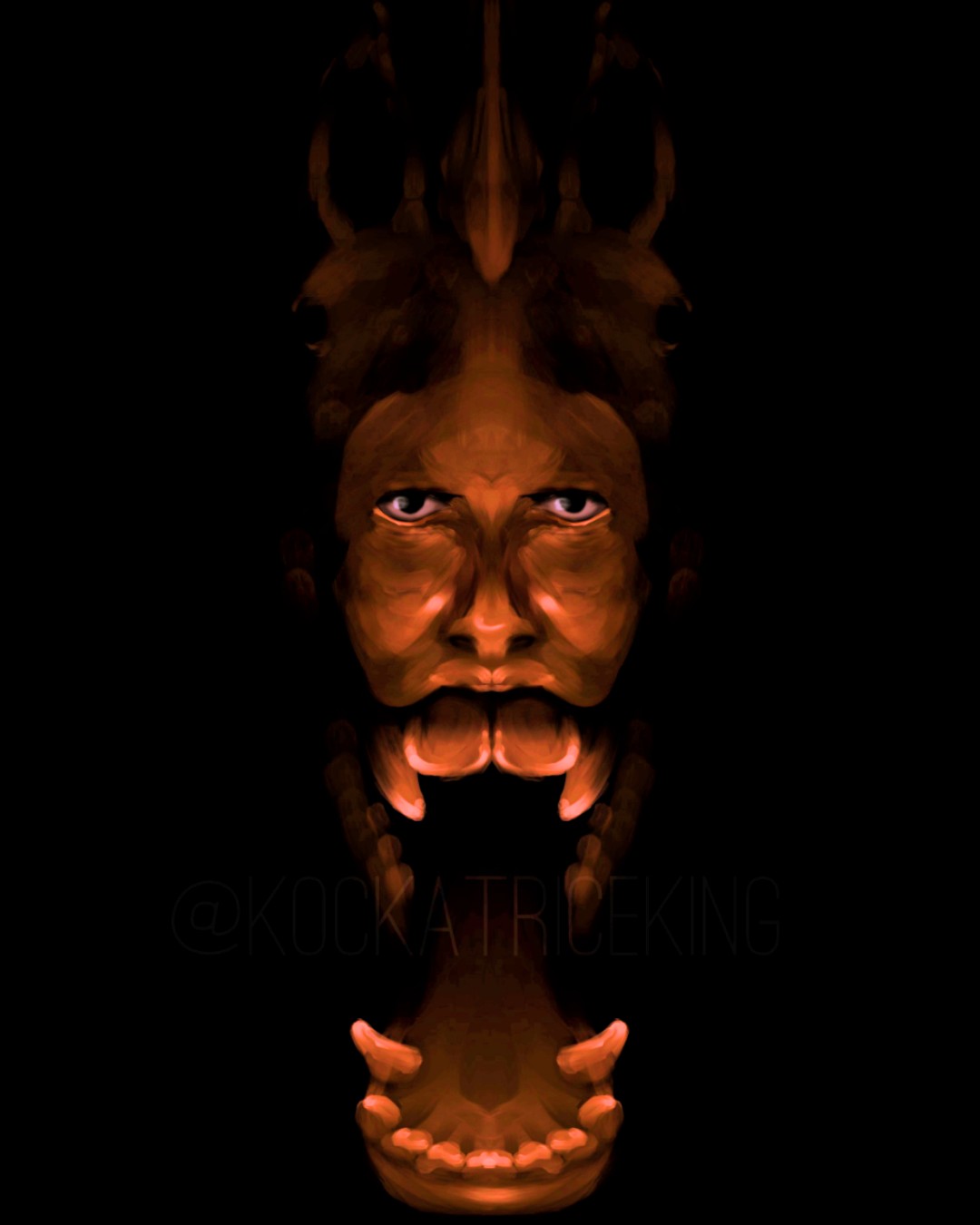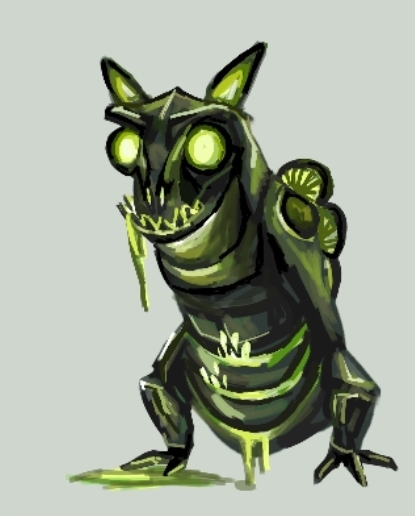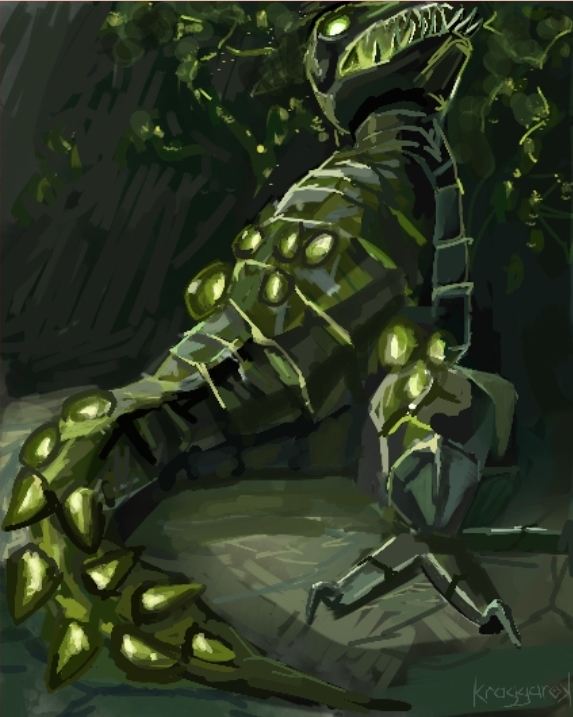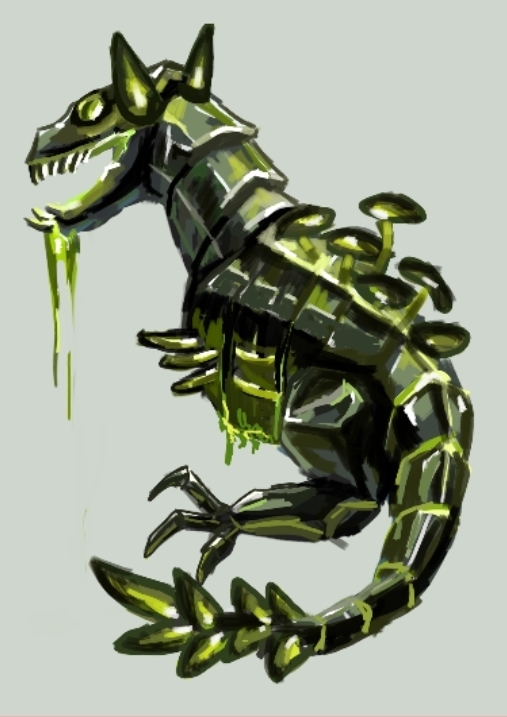CREATURES
The beasts of Sunset Requiem are as varied as they are vicious.Humans
The indomitable creatures who made themselves into the image of Gods. They are the most populous sapient life on this world, closely followed by their own creations.
Human Characters
Mutants
People with animal traits or unnatural abilities, born from the God Wars and the influences of the Rift. Their Contracts have been edited from the baseline human one. Not allowed in the Cities or Undergrowth, but unlike monsters are capable of self-sustaining populations and retain a largely human form. Primary population in the Plains. Mutant CharactersSlipskins
People whose shape is neither here nor there. A single soul divided across twin bodies, a complex contract continously carried through copious conceptions. Those who walk in two-step.Pterippus
Those who change between humans and winged horses. Often work as couriers and postal masters. The largest postal network in the Plains is the Pterippus Post.Kelpies
A more marine inclined version of people who become horses. Relatively rare, especially with Boarate's oceanic expansion.Selkies
People who become seals. Soft skin and pretty pelts hide sharp fangs and drowning seas. Driven ashore by Boarate in recent years.Werewolves
Those who change from wolf to man. One of the earliest forms of slipskins. Typically found around external Undergrowth tracks following clan traditions.Unicorns
A horned horse is a horned horse of course, except when it's a man. The original equine slipskin. Known for being especially violent and exceptionally rare. The Contract is tied to a recessive gene.

Artifical Slipskins
A mockery of an already unnatural being. Puppets on metaphysical strings, broken promises and shattered minds.Details
Slipskins are an entirely Wasteland phenomenon, a unique anomaly unable to be recreated but passable through maternal blood. However, this has not stopped the Cities. Because the Rift is closed, true Slipskins with the bodies combining can never be artificially Contracted, but the mind melding can be. In the last few decades after the end of the God Wars, Ascent scientists in the Anghenfil creation department captured a Slipskin who attempted to enter the City of Viperalm. She attempted to barter with them, agreeing to experimentation in exchange for sanctuary. She was subsequently killed when her pegasus was shot in an attempt to see how far the connection went. Although the pegasus' consciousness remained within the patient, the patient was driven to insanity by what had occured and took their lives shortly afterwards. However, they did not die in total vain, as a single scientist managed to record a part of her Contract moments before its destruction. He attempted to and successfully created a machine which used part of that Contract to place one consciousness in the body of another. However, his own ego blinded him. In an attempt to prove utility, he bound himself to the Drunk, a failed Anghenfil destined for destruction. It worked, and he was immensely pleased- only to be sabotaged by his understudy. When the machine was broken the Contract shattered and he was left in an oscillating state between both bodies. This awakened the Drunk's consciousness, which prompty fought back and caused the containment breach of 65PSTR. Before the Drunk's awakening however the machine was used once more, on an Angel soldier believed to be a traitor having been caught helping outsiders within the Walls. Commander Jean-Claude was shot thrice in the neck, chest and lung, leading to rapid destabilisation of his vitals. Unwilling to waste talent as prestigious as his, Ascent quickly transferred him into the Anghenfil unit where his consciousness was placed within a new therizinosaurus model. Shortly afterward his body passed. However this revealed a new flaw in the system- namely, the death and mental state of the main body. Because the Commander had been near-death at the time of the transfer, his consciousness was weak. It was subsequently absorbed by the Anghenfil's consciousness and as such overtaken. The Anghenfil re-awoke as an intelligent monster, not a man using the body of one. Jean-Claude was scheduled for destruction but escaped in the breach caused by the Drunk. The Slipskin project was declared a failure and defunded. The Drunk’s understudy was shot. However, his consciousness flowed into 0UTRUN’s ghost traps, and his knowledge was absorbed by the AI. That knowledge was then used to create the Commissioners. The technology was sold to Eris and later became Cyber-Blue.Souls / Ghosts
Souls. Whoever said the dead rest easy? In a world seperated from the Gods, the living have nowhere to go. Life finds a way.
Details
When the Rift opened and Humanity caught a glimpse of the Crossroads, a discovery was made. Souls are very much real, and a quantifiable aspect and organ of the living body. Like every other part of life, they were studied and examined, given scientific names and tested to their limits to learn exactly what made them go. And just like everything else in the body, humans figured how to take advantage of souls. A soul contains all the knowledge of the brain, an intangible replica of the human psyche- or perhaps, it is the human psyche. The soul will replicate any effects on the brain- for example, if someone sustains a brain injury and loses their ability to read, their soul will no longer be able to read. The effects will be permanent if the soul is removed from the body before the brain has a chance to heal- something Lawrik took advantage of when creating Steel Soldiers to remove their memories and emotions.Once the soul is removed from the body, the body will cease to function but will not die- as if all parts of the brain not essential for life had been deactivated. It was discovered a soul can be removed from the body and used elsewhere so long as they have a piece of living organic tissue to bind to. Souls function best when the tissue they are bound to is of the same genetic origin as their own body. Souls can still be used even when the body or tissue the soul was attracted to is dead, but will no longer be able to learn, becoming something like a computer with maxed storage.
These dead souls are called ghosts. Ghosts are often used for their knowledge, used to manipulate machines or act as referential tools. Ghosts must be caught in soul traps, which can be both physical and digital. Due to the latter, ghosts are commonly interwoven into computer programs to serve as a form of memory that doesn’t need vast storage modules. The reason ghosts are used is because even though they are limited, a copy of a human brain is significantly more advanced than any computer can be. Ghosts woven into computer programs are called viruses. Viruses are usually made from deceased soldiers, who even in death must still serve.
Viruses can be destroyed with special snippets of code that crawls through code and undoes the ritual soul trap code, freeing the ghost within. Within the Cities anti-viruses are constantly being produced and forced onto the population to get rid of any lingering ghosts from the past. However, in the Wastelands these anti-viruses are rare and it’s exceedingly common for a device to have a virus within, to the point where if your phone isn’t possessed by some dead guy you’re a bit weird.
Ghosts that aren’t bound to anything tend to just sorta exist in the world, unable to leave due to the closing of the Rift. Eventually they either dissipate or are destroyed, if they aren’t recaptured. Ghosts also form naturally upon someone’s death if they happen to be particularly exposed to Rift radiation, which… pretty much everyone is.
0UTRUN is a special virus, as it is a constantly expanding collective due to a specialised soul trap that passively catches any passing ghosts. Because of this 0UTRUN is vastly intelligent and hence can run its company and come up with "new" ideas (ideas someone within the collective had before death).
Steel Soldiers use the soul principle to power their mechanical bodies, with only a scrap of organic material within to bind the person to. The soul principle is also used within the Cyber-Blue project.
Machines
The orders remain even as the steel decays. The machine must obey. Machine CharactersDetails
Machines are machines, devices consisting of fixed and moving parts that modifies mechanical energy and transmits it in a more useful form, usually to perform or assist in the performance of a human task. Machines famously lack a soul, and yet here in the post-Wars land, some don’t.Viruses
Ghosts in the machine are viruses. Life in the machine is a miracle. In a world without Gods, miracles are cheap. There is use for the dead after all.Details
TBASteel Soliders
The colloquial nickname for the robots built by the Lawrik corporation; with human souls and iron skin, they remain immune to Rift effects. But time corrodes metal just as well as flesh. Machines that use a physical CPU, often organic-based, and are capable of performing a variety of complex human tasks.Details
Steel soldiers are the colloquial nickname for the robots built by the Lawrik corporation. Steel soldiers are made from both actual soldiers and forced conscripts, including refugees. The majority of soldiers underwent invasive brain surgeries before being placed into the machine bodies, the surgery removing a significant proponent of their memories and emotions to ensure there was no rebellion. At the start of the war the first steel soldiers were built with almost all their organs still within them, as at the time the limits of the soul were still unknown and being tested. As generations progressed they realised you didn't need that much living tissue to keep a soul alive and so each new version of steel soldier had less and less flesh until the last generation (Jackknife's generation) only had their hearts remaining, kept alive by high tech life support built into the steel bodies they controlled. This is a large reason many older steel soldiers quickly deteriorated after the war- their life support systems simply weren't good enough/too complex to be repaired outside of military facilities and eventually generations of soldiers succumbed to organ failure. Jacknife's generation fared better as they had the minimal life support equipped and the minimum amount of living tissue remaining. This means their equipment will last a lot longer, but does not make them immortal. The cells will eventually give out.Commissioners
Arguably neither machine nor soul. Arguably both machine and soul. Not dead, not yet. Not alive either. A paradox in a world of plenty.Details
0UTRUN is actively researching new ways of creating viruses that aren't bound by ghost limitations. It eventually collected the souls of Eris scientists and discovered a new technique. It found out souls do not have to be bound to their own tissue- just any living tissue. This was a groundbreaking revelation- the previous hypothesis had been that souls could only function bound to their own organic material. The second relevation came with the collection of an Ascent scientist who had developed the Slipskin project, with knowledge of a snippet of conciousness-transferring Contract. 0UTRUN conducted many experiments until finally it managed to bind the soul of a human to the body of a fish (complex enough to host a human soul, simple enough to not fight back). Unfortunately the soul cannot go far from its host body before it begins deteriorating (the soul, not the body) but it's still a big revelation- a soul doesn't have to die when its organic tissue does. The soul is also a bit more advanced than steel soldiers in that they can be transferred from one host to another like viruses, which soldiers can't do. 0UTRUN continued to experiment and created the Commissioners out of its successful experiments. The Commissioners are basically the "mayors" of each settlement within the Undergrowth, they report back to 0UTRUN. Commissioners are not strictly limited to fish- 0UTRUN experimented, even managing to create large predator hosts by lobotomizing the animal and then damaging the soul enough for the human soul to take over. The Commissioners work like a parody of slipskins- they at first glance seem to be people who can switch between a human body and an animal body. However in reality the animal body is their only real body. The "human" body is a machine. The soul can hop between a variety of different machine bodies, so long as their animal host is within a certain radius (for some reason, distance varies between souls).Titans
Titans, moving yet not living monsters made of natural resources that walk the land, leaving behind a bounty many seek. Not alive, but they are animate.Details
"Harvestmen" is the common name for Titans, the giant animated yet not living monsters that walk the land. Harvestmen are made from natural resources, in the most literal sense- skin of tar, bones of coal, blood of oil and scales of steel. They were created by the Good Gods to replenish desperate war resources. Titans are self-replicating to a degree- one Titan can birth one child. They are not alive, however. They are more akin to automation, or machines, great mobile storage units that can sufficiently self-sustain. Titans gather resources as they travel, fracking the ground beneath them for constant replenishment. They "die" after a while, falling under their own weight. For the majority of Wastelanders, it's believed that it is impossible to kill a Titan. Only some very specialised weapons can put one down, and all of those are owned by the Cities, who aren't exactly willing to share. When a Titan falls, it is known as Harvest-fall, and is a very famous event in the Wastelands where thousands of mobile trading towns will gather to claim the precious resources within. Once sufficiently stripped to a manageable size, the creatures will rise again, and begin their ceaseless march anew to gather more resources and grow titantic once more.Monsters
Man-made beasts designed to be living nightmares. Will what man made be his own undoing? Monster CharactersDetails
“Monsters” refers to animals that were not created through evolution but instead formed as a result of the God Wars. Often taking strange and fantastical forms, these creatures are as animalistic as any natural beast and work mostly off wild instinct, with little capacity for higher thought. This apparent lack of intelligence, compounded with most monsters’ inability to conceive, made them a wildly underestimated component of the Wastelands, expected to eventually go extinct once their lifespans passed. After all, by their very nature they are simple, uncooperative fauna. These Monsters are dubbed Generation Zero. This soon changed with the (accidental) creation and release of Jean-Claude, whose escape led to her discovery of Lust, a Remnant of War. Jean-Claude utilised Lust to breed monsters previously thought infertile and create a new generation of monsters, collectively titled the Children of the Beast. These new monsters were fertile, capable of self-sustaining populations, and were markedly more intelligent beings, with the ability to cooperate even across predators and prey. However, their biggest influence was the Hive. Every new monster born was born linked to a hivemind, having the innate ability to understand each other- and most importantly, communicate over a long distance. The head of this hivemind is of course Lust, who in itself is headed by Jean-Claude. The new monster generations (One through to Five, currently) are breeding rapidly, with the population having quadrupled since the escape of Jean-Claude. They also apparently share some kind of hive-mind or telepathic intelligence, able to communicate silently and simultaneously across great distances. The Cities still have an antiqued view of the beasts, and do not consider them a threat. The Wastelanders sharing a home with them strongly disagree.Anghenfil
Anghenfil (lit. 'monster') is the term for monsters created by Viperalm post-Closure. Notable Anghenfil include Jean-Claude and the Drunkard. The name is always capitalised, as they are a brand.Bells of Saint Christopher
The most populous monsters of the Plains. Their presence marks the edge of the CotB's border. Bells cry out once every thirty minutes, a regularly pulsing pattern of echoes across the border that creates a near-constant calling back and forth between the small creatures. This audible cry is supplemented by the hivemind these simple creatures share with all monsters. If the calling pattern is interrupted, or intruders are seen, the alarm cry is given, and the Saints arrive.
The Saints are the matured Bells, hatched from the cocoon about the size of wolves, with the same armoured shell as the Bells but taken to an all-over covering. They produce the same sap but as a far more toxic, acidic form, which they can spit with unerring accuracy up to six metres. Saints eat small mammals and meat, but will happily hunt creatures as large as men. Saints are bipedal. They do have forelimbs, but they are small and stunted in favour of powerful hind legs that can run up to thirty-eight miles per hour, making them a real threat to human intruders. They are much more mobile in their mature form and often roam the boundaries of the border in packs, seeking those unlucky fools who wander too close.
The glowing green round protrusions on their back are actually eggs, and grow naturally on the female Saints. Males carry mushroom-like spermatophores, which they pass to the female during mating. Once fertilised, the female transfers the eggs to suitable trees where they stick and grow and hatch into Bells. The species reproduces at an incredible rate- one female can produce 60 eggs in a batch.
Bells cry out once every thirty minutes, a regularly pulsing pattern of echoes across the border that creates a near-constant calling back and forth between the small creatures. This audible cry is supplemented by the hivemind these simple creatures share with all monsters. If the calling pattern is interrupted, or intruders are seen, the alarm cry is given, and the Saints arrive.
The Saints are the matured Bells, hatched from the cocoon about the size of wolves, with the same armoured shell as the Bells but taken to an all-over covering. They produce the same sap but as a far more toxic, acidic form, which they can spit with unerring accuracy up to six metres. Saints eat small mammals and meat, but will happily hunt creatures as large as men. Saints are bipedal. They do have forelimbs, but they are small and stunted in favour of powerful hind legs that can run up to thirty-eight miles per hour, making them a real threat to human intruders. They are much more mobile in their mature form and often roam the boundaries of the border in packs, seeking those unlucky fools who wander too close.
The glowing green round protrusions on their back are actually eggs, and grow naturally on the female Saints. Males carry mushroom-like spermatophores, which they pass to the female during mating. Once fertilised, the female transfers the eggs to suitable trees where they stick and grow and hatch into Bells. The species reproduces at an incredible rate- one female can produce 60 eggs in a batch.
 Male Saints appear more canine, with lithe builds and greater speed, whereas female Saints appear more saurian, with no external ears and a blunter head.
Male Saints appear more canine, with lithe builds and greater speed, whereas female Saints appear more saurian, with no external ears and a blunter head.

(Saints & Bells designed and drawn by Kraggarok)